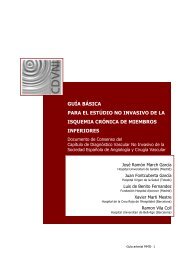Guía básica para el diagnóstico no invasivo de la insuficiencia ...
Guía básica para el diagnóstico no invasivo de la insuficiencia ...
Guía básica para el diagnóstico no invasivo de la insuficiencia ...
You also want an ePaper? Increase the reach of your titles
YUMPU automatically turns print PDFs into web optimized ePapers that Google loves.
• SHUNT TIPO 3. El punto <strong>de</strong><br />
fuga es d<strong>el</strong> mismo tipo que<br />
<strong>el</strong> shunt anterior, existiendo<br />
una co<strong>la</strong>teral <strong>de</strong> safena<br />
interpuesta entre <strong>la</strong> columna<br />
<strong>de</strong> máxima energia y <strong>la</strong> reentrada<br />
principal. Es un<br />
shunt cerrado.<br />
• SHUNT TIPO 2.- Es aquél<br />
cuyo punto <strong>de</strong> fuga parte <strong>de</strong><br />
<strong>la</strong> propia safena. Pue<strong>de</strong>n ser<br />
abiertos en <strong>el</strong> caso <strong>de</strong> que <strong>la</strong><br />
co<strong>la</strong>teral <strong>de</strong>semboque por<br />
una perforante al sistema<br />
ve<strong>no</strong>so profundo. o cerrados<br />
cuando <strong>la</strong> co<strong>la</strong>teral<br />
insuficiente <strong>de</strong>semboque en<br />
<strong>la</strong> propia safena.<br />
<strong>Guía</strong> <strong>de</strong> <strong>la</strong> Insuficiencia ve<strong>no</strong>sa - 18



